The Zion Muleteers of Gallipoli
- Home
- World War I Articles
- The Zion Muleteers of Gallipoli
[This article was first published in Gun Fire No. 50. All of these magazines are now available to WFA members' via the Member Login. Joining the Western Front Association gives you access not only to the 59 editions of Gun Fire but also to all 110+ issues of the WFA's in house journal Stand To!]
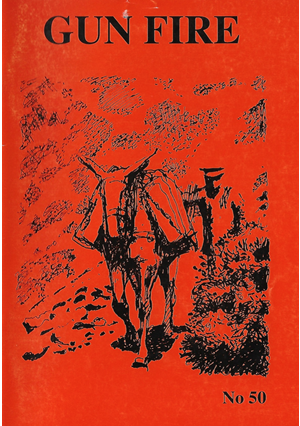
The Zion Muleteers of Gallipoli by Martin Sugarman
March 1915 saw the formation of the Zion Mule Corps (as a unit in the British Army), the first independent Jewish fighting force to take an active part in a war since the destruction of the Temple by the Romans 2,000 years ago. It marks a momentous point in Jewish history; many of the men involved later formed what was to become the core of the modern Israeli army. General Sir Ian Hamilton, C-in-C of the Anglo-French Expeditionary Force in the Dardanelles, was later to write (27 August 1915) in his diary, 'I have here, fighting under my orders, a purely Jewish unit - the Zion Mule Corps. As far as I know, this is the first time in the Christian era such a thing has happened. They have shown great courage taking supplies to the line under heavy fire' and have proved invaluable to us (the extract was published in the American Yiddish newspaper Der Tag- The Day- 7 August 1917).
The commander of the Zion Mule Corps was Lt Col John Henry Patterson DSO, a tall, elegant and experienced Boer War veteran of Northern Irish Protestant origin, born in Dublin in 1867. He arrived in Egypt during WW1 just at the moment when the British Commander in the area, General Sir John Maxwell, was looking for a suitable officer to raise and command a Jewish military unit to fight against the Turks in the Middle East.
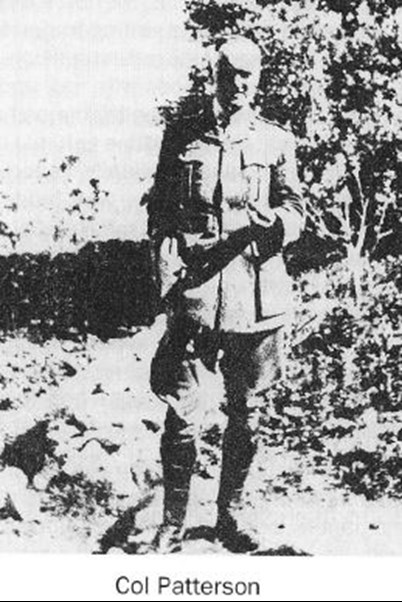
In Alexandria, at the time, were several - perhaps 11,000 Jewish refugees - many Russian speaking- who had fled or been expelled from Palestine by Turkey and were being cared for by the Egyptian Jewish community in barracks at Gabbari and Mafruza. Many wished to put themselves at Britain's disposal to liberate Palestine from Turkish rule and so take a step towards the dream of a reborn Jewish Homeland.
A few weeks before, on the evening of 23 February 1915, a Jewish committee of eight had met at the house of Mordechai Margolin or Margolis in Alexandria. They included the noted Zionist leaders Ze'ev Jabotinsky and Joseph Trumpeldor. These two veterans had met before and they put their plan about the raising of a Jewish Legion to the committee, who voted for it by a five to two majority, one member abstaining. On 2 March, in a dim hall -a converted stable-of the Mafruza barracks, about 200 Jews met to discuss the plan. By the end of the evening, 100 signatures had been put on a piece of paper torn from an exercise book, on which was written a seven line resolution in Hebrew.
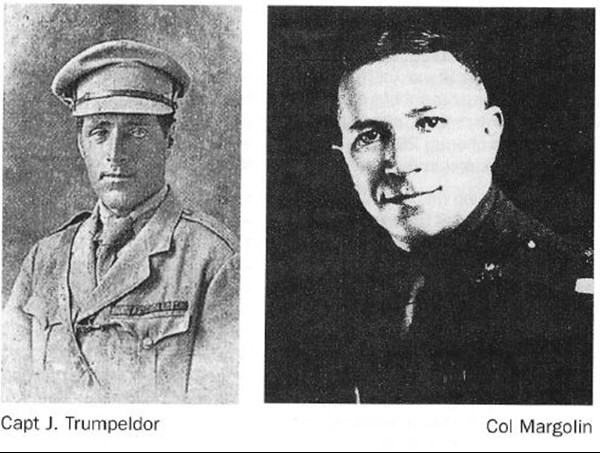
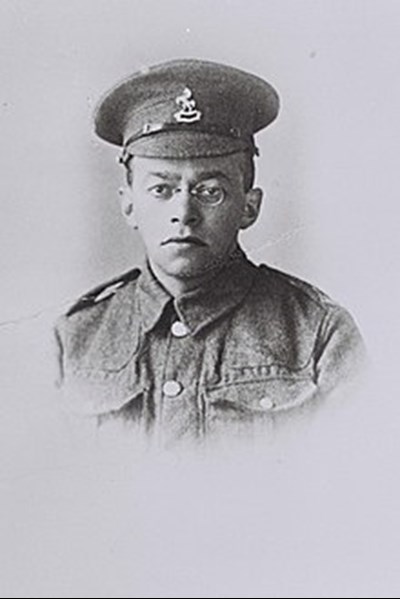
Ze'ev Jabotinsky
The British were well aware of how much a Jewish fighting unit would benefit their war efforts. The committee, and representatives of the volunteers then went to Cairo to see Ronald Graham, the minister responsible, who was sympathetic to them but told them they had to see Maxwell. When the Jewish delegation led by Jabotinsky saw the commander, however, he said he was unable (under the Army Act) to enlist them as fighting troops as they were foreign nationals. He could only form them into a volunteer transport Mule Corps though they would be fully trained for combat (to begin with they were called The Assyrian Jewish Refugee Mule Corps!) It was further known that whilst aliens could be enlisted into the British Army, the Act forbade their numbers exceeding two per cent of any Army Corps to which they were attached.
The delegation left Maxwell and later, at an all night meeting, the civilians, including Jabotinsky, rejected the commander's proposal, but Trumpeldor did not. With three others, he called another meeting at Mafruza and the volunteers agreed to go ahead. It would be the first time in British history that non-Britons or colonials were admitted as a unit into the British forces.
J.H. Patterson was very knowledgeable of and sympathetic towards the Zionist cause in particular, and Jewish history in general, and as a young man had devoured all that was to be known of Jewish military and religious history from the bible. On 19 March 1915, backed by his friend and fellow officer Major General Alexander Godley, he was appointed commander of the new force he was to recruit, with Trumpeldor as second-in-command. They left Cairo for Alexandria, where the Jewish refugees were living, setting up Headquarters at 14, Rue Sesostris. With the help of leading members of the Jewish community - especially the Grand Rabbi Professor Raphael della Pergola - and with an emotional telegram of encouragement from Israel Zangwill the noted author and British Zionist leader (who later described Patterson in the Jewish Chronicle in 1915 as 'the soul of chivalry and gentleness' - he swore in the volunteers at Gabbari, just outside Alexandria, on 23 March with the Grand Rabbi officiating at the ceremony. The Rabbi referred movingly to Patterson as another Moses who would lead the Children of Israel again out of Egypt to the Promised Land.
The Jewish Chronicle reported that Zangwill's telegram had read 'Welcome omen for their happy return to Palestine'. But on reading this, Zangwill wrote to the paper on 7 May denying this wording and said his 'telegram had been toned down by the local military censor' but that Col Patterson had said to the assembled troops, 'Pray with me that I should not only, as Moses, behold Canaan from afar, but be divinely permitted to lead you into the Promised land'.
Some Jews had been against the forming of a mule corps and refused to join, complaining it was demeaning for them to enter the arena of Allied armies as a 'donkey battalion'. But, Trumpeldor argued, 'we've got to smash the Turk. On which front you begin is a question of tactics. Any front leads to Zion'. Patterson told the men that the soldier who carried ammunition and supplies to the trenches required no less courage than the man who fired a rifle. These views prevailed and hundreds, including many Egyptian Jews, volunteered for service.
Petrov, the Russian Consul in Alexandria, used his influence to try and force the Egyptian and British authorities to insist that the Russian Jews be sent to Russia - much against their will - to enlist in the Tsar's army. The Grand Rabbi used his contacts to foil this.
The sanctioned strength of the Mule Corps (which was officially designated a Colonial Corps of the Egyptian Expeditionary Force) was allowed to reach 737 men, all of whose names may be found in The British Jewry Book of Honour. (https://www.jewsfww.uk/roll-of-honour.php) In addition it was allocated 20 horses for officers and NCOs and 750 pack mules, purchased in Alexandria. There were five British and eight Jewish officers and the Grand Rabbi was named as Honorary Chaplain.
Patterson's most famous Jewish officer was the aforementioned Joseph Trumpeldor, born in Piatigorsk in the Caucasus in 1880, who had lost his left arm as an officer in the Russian army at the siege of Port Arthur in the Russo-Japanese war. He had received the Gold Order of St George no less than four times by the Czar for gallantry and had been a prisoner of the Japanese. He was the only Jewish officer permitted in the Czar's army! A socialist lawyer and vegetarian, he was tall, powerful, fearless and Nordic looking and been a kibbutz farmer on the shores of the Sea of Gallilee until forced into exile in 1914. Patterson described him as 'the bravest man I ever knew'.
Many of the soldiers were educated, professional people - students, teachers, lawyers- and they included Dr Meshulam Levontin who became the commander of the medical unit.
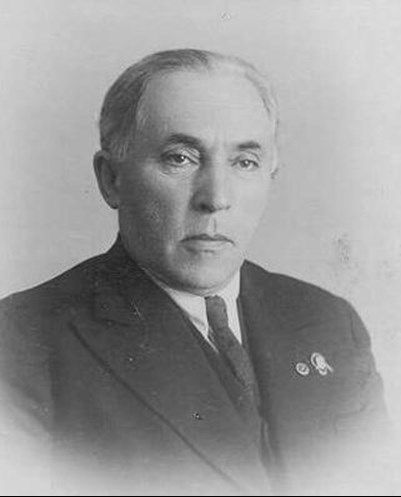
Above: Dr Meshulam Levontin
The Corps consisted of four troops, each with two officers; each troop with four sections with a sergeant; and each section was split into sub-sections with a corporal in charge.
Patterson was given a site for a camp at Wardian outside Alexandria. Here his men pitched their tents on 2 April 1915. Patterson wrote, 'never since the days of Judah Maccabee had such sights and sounds been seen and heard in a military camp-with the drilling of uniformed soldiers in the Hebrew language' (in fact, Yiddish was also used as 75 per cent of the men were of Russian origin and Yiddish was a lingua franca for them). Their badge consisted of the Magen David/Shield of David. (There is some doubt as to whether this was ever issued, but in an interview with the Jewish Chronicle on 24 March 1916 Patterson said he and the men wore the badge and that 'sometimes I would meet a General who would be puzzled out of his life by the Magen David but naturally would not care to admit his ignorance. When he found out what it meant, he would say "Oh yes! I know- and very good work your Corps has done too!". The Corps also made a blue and white Zionist/Israeli flag to fly alongside the Union Jack. Though a mule corps, the members were all equipped with rifles, bayonets and ammunition, as they were expected to be a fighting unit (the rifles were captured by the British from the Turks at the Suez Canal).
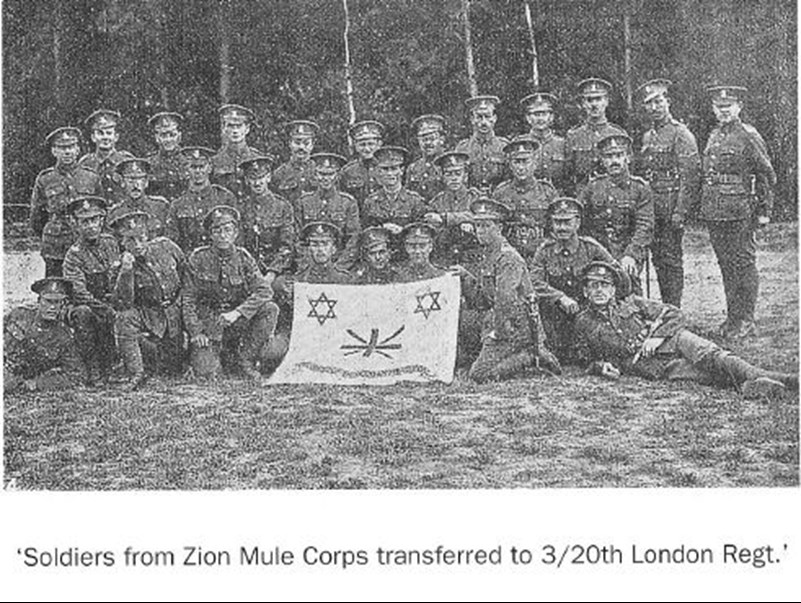
For three weeks intense training went on from dawn till dusk as the Corps was under orders to sail for Gallipoli. Their job there was to supply front line troops with food, water and ammunition. The newly appointed C in C of the Mediterranean Expeditionary Force to Gallipoli, General Sir Ian Hamilton, carried out an on-the-spot inspection and was delighted with the workman-like appearance of the Corps after such a short time of training. At Pesach (Passover), Patterson (known to his men as the 'Collon-el'), fought unfriendly attitudes in high places to get his men Kosher food and Matza (unleavened bread) for the Passover meal celebrations, in which he fully participated. After Pesach, the Corps paraded and marched three miles to the Great Synagogue in Alexandria where they were blessed in an emotional ceremony by the Grand Rabbi and cheered by the local population. They then sailed on HMT Hymettus and HMT Anglo-Egyptian on 17 April from Alexandria (singing 'Hatikvah', the Jewish and later Israeli anthem) to Lemnos, arriving there three days later. In the harbour they astonished many of the English soldiers by chatting freely in Russian with the sailors of the Russian cruiser Askold.

Above: Russian cruiser Askold on trials after construction at Kiel
At Lemnos Patterson was informed that (under protest) the ZMC was to be divided into two; the Hymettus group (about 300), which was to accompany the 29th Division, and the remainder the ANZAC Division. Patterson foresaw what would happen. He was not with the ANZAC group and the men - unused to soldiering and mismanaged by strange officers became demoralised and after three weeks were returned to Egypt. The remaining men were transferred to HMT Dundrennon and sailed for Gallipoli on 24 April. On the following morning in the mist, the ZMC aboard Dundrennon approached Cape He lies at the extreme southern tip of the Gallipoli peninsula. They heard distinctly the dull roar of the guns of both Allied ships and Turkish shore batteries, and saw smoke, flames and debris as high explosive smashed into the beaches and cliffs. Circling aircraft and prowling submarines were in evidence. The landings had just begun.

The ZMC stopped off V beach, just to the west of Cape Helles, but could not get ashore till the following evening owing to congestion on the shore. It took them three days to unload. By this time the Corps badly needed to take up supplies to the front line trenches, and once ashore went straight to work under intense enemy fire. (In the War Office Order of Battle, they were a Line of Communication Unit.) Two hundred mules were ordered to take water and ammunition to W beach accompanied by Patterson, whilst the remaining troops finished unloading at V, under heavy fire. From W beach the Corps worked alI night and through the next day taking supplies to the front in pouring rain, which made existing primitive paths into mud slides. Often the men and animals walked unknowingly through the wire and trenches of No Man's Land being shot at by both sides in the confusion of darkness. Finally, at dawn, they were stood down, utterly exhausted, yet miraculously, with only a few wounded men and mules!
In an interview with Patterson published in The Jewish Chronicle on 10 September 1915 (given whilst he was recruiting in Alexandria) the Colonel recalled the landing; 'These brave lads who had never seen shellfire before most competently unloaded the boats and handled the mules whilst shells were bursting in close proximity to them ... nor were they in any way discouraged when they had to plod their way to Seddul Bahr, walking over dead bodies while the bullets flew around them .. .for two days and two nights we marched .... thanks to the ZMC the 29th Division did not meet with a sad fate, for the ZMC were the only Army Service Corps in that part of Gallipoli at that time'.
In a gully near the front, the ZMC made its first camp and mule lines. By an amazing stroke of luck, Sgt Farrier Leib Schaub discovered a hidden well in the corner of a demolished Turkish farm house, thus solving the problem of water for the animals. Whilst some slept, parties of men and mules took turns taking up forage, water and ammunition from the beaches to the front all through the day and the following night. The Corps was the only transport available and was constantly at work.

In a strange incident on V beach, a ZMC soldier who had been left guarding the baggage became an object of suspicion by some French soldiers. He could only speak Russian or Hebrew, which must have sounded like Turkish to the French, and as he had a captured Turkish rifle and bayonet, he was taken for a spy, court martialled and condemned to be shot. He was about to be executed when the ZMC Sergeant in charge realised what was happening. He could speak French, and a tragedy was narrowly averted.
The men of the Zion Corps slept like logs, and it is said that one man woke up to find he had been shot through the leg, and had not woken up. On the night of 1 May, a Turkish shell landed near the mules and 40 galloped off into the darkness. This saved the British army that night because Turkish soldiers had been creeping in three waves towards the British for a night attack. The terrified mules with clanking chains, some wounded, careered into the Turks, who took them for charging British cavalry. They began shooting, giving away their positions. Then the British opened such intense fire that the attack utterly failed. On 5 May, near Krithia, Pte M. Groushkousky distinguished himself by preventing a number of mules from stampeding during an attack, exposing himself to enemy fire. Although shot through both arms, he kept hold of his charges and delivered his ammunition to the trenches. He was decorated for gallantry in the field with the DCM by General Stopford and promoted to corporal. Another strange incident to add to that of the 'execution' involved an English soldier Sgt James Matin. Badly wounded in the leg he was carried to a field hospital where doctors found his shin bone splintered. But a graft was hastily made from the bone of a dead ZMC mule, and his leg was saved.
Although officially forbidden to do so, the Zion Mule Corps took part in a charge with the lnniskilling Fusiliers, against Turkish trenches. Reaching their lines with supplies, the ZMC saw the attackers had been reduced in numbers by many casualties. So, they joined the charge, led by Cpl Elie Hildesheim.
Another ZMC story related how men refused to unload sides of bacon from the jetty until the Grand Rabbi granted dispensation. This he did, as well as allowing them to eat it if necessary. They then applied, unsuccessfully, for their rejected unkosher rations! Later, a New Zealand officer wrote how it always amused the troops to see the Jews of the Zion Mule Corps returning to their cookhouse with little bags of bacon!
Capt Arthur Behrend, a Jewish officer serving with the East Lancashire Regiment, wrote in his diary how, on 10 May, he was sent to enlist the help of the ZMC.
I found the Mule Corps in an open meadow. With much saluting I was taken to the C.O., Colonel Patterson ... and he handed me over a corporal, six men and fourteen mules. 'Take great care of my men and don't expose them', he said as he wished me goodbye. 'The mules don't matter so much because they can be replaced more easily'. I returned to our lines followed by the stolid Zionists and the equally stolid mules, and handed all over to our astonished Transport sergeant...half an hour later I strolled across to see how they were getting on and found them all sitting round a big fire with our own transport section, a dixie of tea boiling merrily in the middle. East Lancashire Arabic quickly became the lingua franca because our men had picked up a number of Arabic words in Egypt; equally quickly too the Zionists won respect and affection because despite their over fondness of saluting, they showed a curious disregard for shell fire.
On 11 May, the ZMC moved two miles inland and bivouacked at a place which became their base for the next seven months. From here several men were evacuated with battle fatigue and disease. During intense shelling on 20 May, the Turkish guns seriously wounded several more ZMC men and killed a dozen horses and mules. Behrend wrote that on Sunday 23 May, as the padre arrived to take a service in his lines, a Turkish shell landed, dispersing the congregation. The only soldier who did not move was a ZMC man grooming his mule; sadly, a second shell killed him as the mule ran off. This was probably Pte Katznelsohn, whose death in action, however, is given as 30 May in a list of casualties.
Around this time, reports reached ANZAC HQ that Indian troops fighting with the Allies near The Nek, had been mistaken for Turks. The shout 'Don't shoot- Indian Troops!', had been used as a ruse by Turkish skirmishers raiding Allied trenches. It was believed for a short while that Turkish agents were operating behind Allied lines and the ZMC came under suspicion, so much so that arrangements were made to withdraw them. However, it transpired that nervous Australian sentries were to blame and the matter died down. This is referred to by C.E.W. Bean, the Australians' official historian.

CEW Bean working on the Australian Official History
Through May, June and July 1915, the ZMC doggedly continued its dangerous and important work in the ever deteriorating situation on Gallipoli, and Patterson received dozens of letters from senior officers testifying to the excellent and fearless work of his men. Their courage even reached the ears of Djemal Pasha the Turkish Commander in Palestine, who was indignant when he discovered that a unit of Palestinian Jews was fighting against the Turks on the peninsula. On 4 and 5 June the ZMC performed particularly distinguished service, taking up ammunition and evacuating wounded during the Third Battle of Krithia. Here Trumpeldor was wounded in the shoulder but refused to be evacuated (he was later to be killed fighting Arab raiders at Tel Chai in northern Israel in March 1920). Pte Nissel Rosenberg, under intense fire, brought his supply mules through to the front line when many reinforcing troops were retreating. He was recommended for the DCM and promoted to Sergeant, but received a Mention in Despatches (announced 8 August 1915), as did Lt C. J. Rolo. Sgt Mayer Erchovitz received the DCM as well as being Mentioned in Despatches (7 January 1916).
By the end of July 1915, the ZMC was down to less than half its original strength, and by the end of the Gallipoli campaign, over 100 mules had been killed in action. The intense heat and plagues of flies was almost as effective as Turkish shelling in creating casualties, so Patterson was ordered to Alexandria to recruit two fresh troops.
By now, a considerable stir had been created by the raising of the Zion Mule Corps and the courage shown by its members in Gallipoli, but they did not get a mention in the Jewish Chronicle till 9 April 1915 when it stated, seemingly somewhat surprised, that a 'Jewish Volunteer Force was in existence in Alexandria among the Jewish refugees from Palestine'. This was followed by a much longer feature article about the Corps on 30 April. On 4 June the Chronicle reported that Lance Sgt Harry Schoenthal, a Jewish soldier with the 29th Cycle Company serving in Gallipoli, had written to his father in London saying that 'there is something still more interesting, because there is a Jewish battalion here with us ... they do not come from home. Have not had a chance to get to speak to anyone of them yet ... it is splendid to see so many Jews serving here'.
On 18 June, a Jewish naval officer, who was a manager of the Oxford and St George Jewish Youth Club in Stepney, wrote to Sir Basil Henriques, saying that he had heard Yiddish being spoken in the trenches on Gallipoli.
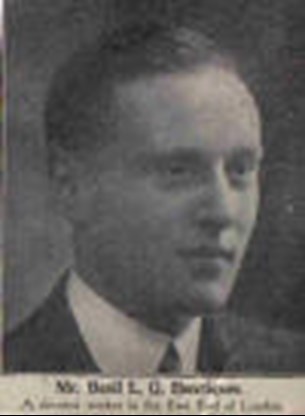
Basil Henriques
On investigation he had discovered the Zion Mule Corps. Men of the ZMC did not believe he was a British officer, so he showed them the club badge which he always carried. They were flabbergasted and gave him a captured Turkish bayonet as a parting gift which he claimed as 'the Club's property as it was obtained by means of the Club badge'. Later, he asked some English officers about the ZMC. They said 'they were most excellent fellows and though they were nearly all merchants and shopkeepers in private life and had no experience of outdoor life, yet they made splendid soldiers and had suffered many losses.' On 23 July a young engineer from Headingley attached to the Royal Naval Division was reported in the Yorkshire Evening Post as having 'met on landing a party of Russian Jews from Palestine who lent us their mules for transport and carried out some wonderful but unostentatious work for us at the Gaba Tepe landing'.
(In a taped interview, made in 1984, Major John Ford ex RAMC, then aged 85, told of an incident in the Second World War about when he was serving in Iraq. He was on an overnight train to Baghdad, when a man in a shabby raincoat entered his compartment. He spoke in broken English wishing Ford a good evening, then took off his coat to reveal an RAMC Colonel's uniform. They began to talk about the WW1 medal ribbons each was wearing and soon discovered they had both served in Gallipoli. It transpired that the Colonel had been a private in the Zion Mule Corps and on the Hymettus in 1915, as had Ford! lt turned out, too, that the Colonel was now the Middle East British Army's Chief Malariologist - Ford was unable to remember the Colonel's name.)
On 25 July 1915, Patterson, Trumpeldor and Groushkoushy sailed for Egypt. At a meeting in Cairo's main synagogue, 150 new recruits were raised as the 'Cairo Troops' of the ZMC. On Saturday night 21 August, in the packed synagogue at Rue Nabi Daniel, a scroll of the Law was presented to the new recruits to take to Gallipoli. Three troopers rose to accept it from the Grand Rabbi as he said 'May this scroll of the Torah which has guarded us for thousands of years preserve and bring you back home safely. May our common cause triumph and may it hasten the day of universal peace'. The congregants with much feeling replied, 'Amen!'
A month later, on 20 August, the Jewish Chronicle reported that Israel Zangwill had been in close correspondence with Patterson and that an emissary from Egypt had been introduced by Zangwill to the War Office in London (to Major General Sir Alfred Turner) with funds to recruit Jews from various countries into the Zion Mule Corps, especially from Italy. The WO did not help the idea along and the young Jews of the Cairo troop were taken to join the Italian army instead.
On returning to Gallipoli, Patterson found that Lt Alex Gorodissky had died of illness on 11 August (Gareipy says 11 September). He had been promoted since his enlistment as a private on 23 March 1915 and was a grave loss to the Corps (Appendix 1). Gorodissky, an only son of a widowed mother, had been a railway engineer and mathematics teacher at the Lycee in Alexandria and had turned down a senior engineering post to fight- and die - in Gallipoli. Cpl Zalman Cogan, writing from a hospital bed in England on 11 November said, 'he had been an officer and at the same time best friend of all the soldiers. Owing to his knowledge of English he was the intermediary between us and the Colonel. .. I never heard from him one complaint ... an honest and just man ... we have lost one of the best men of the Corps ... promoted in the field to Lt.'
At the beginning of September 1915, there was a lull in the shelling of the area where the ZMC was as the Turks appeared to run out of heavy ammunition. Dancing and singing around a camp fire became possible, with songs in Hebrew and Russian, but always ending with God save the King and Hatikvah. Earlier, on 6 August, Sgt S.I. Luck wrote to his father at 164, Commercial Road, Whitechapel, from the 1st Australian Base Hospital in Gallipoli, about
patients reaching us from the Zion Mule Corps ... the censorship officer asked "why the devil don't these men use the English language? How can I censor this rubbish?" But he was only telling his dear wife away in Russia that he was sick. "It's either TB or malaria", he cooly explained ... it became rather ludicrous when German is the only language the patient can understand ... one spoke Arabic, his bullet was extricated and wrapped neatly in a piece of bandage, he hung it from his wrist. "would you like to go back and fight those Germans and Turks?" I asked. "Certainly, as soon as I get well. Have I not got all my friends there?" And the men lived in Turkey and spoke German. The irony of fate. But who knows, perhaps the last two factors were the cause of his enlistment in the first place!"
By September 1915 deep communication trenches had been dug on the peninsula and the Mule Corps could actually ride their mules up to the front. They were dubbed the 'Allied Cavalry', and Patterson related the story of how, in October, whilst excavating a dugout for the coming winter, the men found a slab of marble with a huge Star of David carved on it. They immediately erected it as a talisman and in fact the dugout was never hit in the time they spent there, even though shells fell all around it.
On 29 November, Patterson was ill and had to be evacuated to Alexandria, and thence to London where he arrived by 16 December. Trumpeldor took over his command but on 19 December was wounded in the left shoulder by a rifle bullet. He refused to be evacuated and stayed as OC until the ZMC was disbanded. By that December, the Corps was down to five British and two Jewish officers and 126 men.
In January 1916, the Gallipoli peninsula was evacuated and the Jewish muleteers paid formal tribute to their 14 dead comrades. Sgt H.L. Gordon led the prayers at the graves. Then they slashed the throats of their mules, and left. Some went on a transport which was torpedoed. It sank but all the men survived.
Taken to Alexandria, the men of the ZMC were told they were to go to Ireland. To a man they refused, saying they had enlisted to fight Turks, not Irish patriots. So, on 26 May the Corps was disbanded. (Patterson lived more or less to see the Zionist dream come true, not dying until 194 7 in La Jolla, California.)
Most of those of the Mule Corps who died (60 were wounded) were the first Jews to be buried later in the tranquil British War Cemetery on Mount Scopus in Jerusalem, the Star of David on their tombs testifying to their role as the precursors of the Israeli Army.
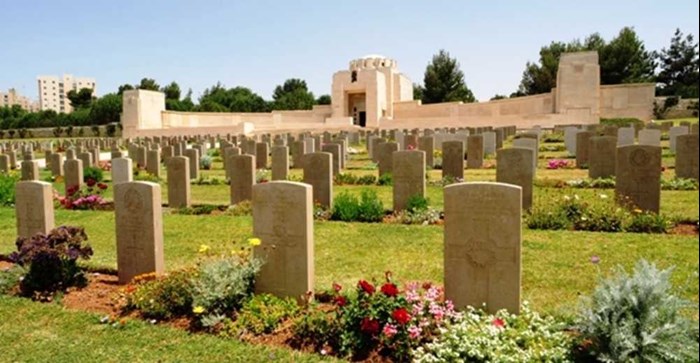
Jerusalem British War Cemetery
At least two, however, are buried at Lancashire Landing cemetery, Gallipoli (Pte Y. Rotman and Pte Nergman). D. Bardin, M. Halimi, I. Kirshner, B. Wertheimer and M. Zaoui died of wounds, and are buried in Alexandria, in the Chatby Jewish CWG cemetery.
General Hamilton wrote to Jabotinsky on 17 November from his home at 1 Hyde Park Gardens. 'The men have done extremely well, working their mules calmly under heavy shell and rifle fire, and thus shown a more difficult type of bravery than the men who were constantly in the trenches and had the excitement of combat to keep them going', he said. In contrast to this, however, he wrote in his diary that 'the Corps may serve as ground bait to entice the big Jew journalists and bankers to our cause; the former will lend us colour, the latter the coin' .This is but one illustration of the anti-Semitism of much of the Army at the time. There are many other examples. The promised Kosher food was often deliberately not provided; Jewish officers were paid 40 per cent less than their British counterparts; had to eat at separate tables; were only eligible for low pensions; and were treated with a lack of courtesy by British officers who were junior to them. This lead to vain protests by Trumpeldor. Despite appalling behaviour of the kind described above, however, many publicly complemented the ZMC. Some have been quoted and Sidney Moseley, a War Office representative at the peninsula did so. He described the Corps as 'an indispensable unit in that campaign'. Brig Gen Aspinall Oglanden wrote that 'Special recognition is due to the Zion Mule Corps for their untiring energy ... bringing up ammunition and water to the forward positions and carrying back the wounded, under very heavy fire', and a New Zealand officer, Major F. Waite, spoke of 'the risks run by the ZMC ... they carried their lives in their hands ... for the enemy had the range to a yard of every landing stage, dump and roadway which they used'. On 15 December, Sir John Maxwell wrote to Trumpeldor at his billet, Pension Tewfiq, Rue Moghrabi, Cairo, praising 'the personal fighting value of yourself and the Jewish volunteers of which ... the behaviour of the Zion Mule Corps under fire in the Gallipoli Peninsular gave ample proof'.
Patterson had used his influence to get the Mule Corps its promised name, badge and flag, fighting army prejudice, probably at the expense of his own career. Teddy Roosevelt wrote to him asking if the ZMC had made as good soldiers as those Jews in the US Army. Cpl Cogan wrote of Patterson, 'His relations with us reminded me more of the care of a father for his children than that of a commander for his subordinates ... the organisation of the Corps meant a good deal of hard work for him and thanks to him ... the Corps was in such excellent condition'. Patterson's name is much honoured in Israel.
Perhaps the last word of praise should be one from Rev Dr Ewing of the Grange United Reform Church in Edinburgh, a Chaplain to the EEF. He is reported in the Jewish Chronicle of 28 January 1916 as saying, 'The ZMC has done most excellent transport work since the landing ... strange it is when you ask a man where he is from to have him say the Holy City [Jerusalem] .. . and very earnest these Sons of Jacob are in their endeavours.'
So the Zion Mule Corps marched into history, a unique unit in military annals. Eventually a memorial to its fallen was unveiled at the Alexandria Jewish Cemetery (Chatby), with representatives of all the Allied nations in attendance, together with hundreds of veterans and local citizens. In 1926 the name of the unit - with all the others which had served - was inscribed on the inner wall of the British Gallipoli memorial at Cape Helles, overlooking V beach where they had come ashore on that fateful April morning in 1915. This was, however, not the end. For 120 of the ZMC re-enlisted and thanks to Patterson and his close friend Major Leopold Amery, were all placed in the 20th Battalion of the London Regiment and became the core of the soon-to-be-formed Jewish Battalions of the Royal Fusiliers (38th-42nd) which were to fight in Palestine as the Jewish Legion or 'Judeans'. Patterson went on to command the 38th Battalion himself (which included Lt Ze'ev Jabotinsky-1880-1940 - and Col Eliezer Margolin, DSO, the Australian Jewish officer who later commanded the 39th Jewish Battalion. The 40th Battalion was to include two future Prime Ministers and one future President of Israel. They were David Ben Gurion, Levi Eshkol and Yitzhak Ben-Zvi.
Article by Martin Sugarman
Assistant Archivist, Association of Jewish Ex-Servicemen and Women, The Jewish Museum





